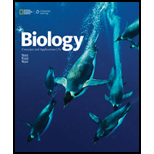
Concept explainers
Introduction:
Energy is defined as the capacity to do work. Living organisms constantly use energy to grow, move, acquire nutrients, and reproduction. In all these processes, there is also a significant loss of energy.
Answer to Problem 1SQ
Correct answer:
Sunlight is life’s primary source of energy. Hence, the correct answer is option c.
Explanation of Solution
Reason for correct answer:
Option c. is given as, “sunlight.”
The energy that fuels most life on Earth comes from the sun. This energy flows through producers such as plants then consumers such as animals. In this journey, the energy is transferred many times. With each transfer, some energy escapes as heat. Eventually, all of it is permanently dispersed. Hence, option c. is correct.
Reason for incorrect answer:
Option a. is given as, “food.”
Food is taken by human beings and animals, but not plants. Plants depend on sunlight for energy. Hence, option a. is incorrect.
Option b. is given as, “water.”
Water does not act as a primary source of energy. It plays an important role in assisting many biological reactions. Hence, option b. is incorrect.
Option d. is given as, “ATP.”
ATP is known as the energy currency of the cell. It is made by the process of glycolysis in which glucose gets break down into pyruvate. It plays an important role in catalyzing many biochemical reactions but is still not considered the primary source of energy. Hence, option d. is incorrect.
Hence, the options a., b., and d. are incorrect.
The life’s primary source of energy is considered to be sunlight. Thus, the correct option is c.
Want to see more full solutions like this?
Chapter 5 Solutions
Biology: Concepts and Applications (MindTap Course List)
- PLANT CELLS ARE PROTECTED FROM THE HARMFUL EFFECTS OF EXCESSIVE LIGHT ENERGY AND REACTIVE OXIDATIVE MOLECULES BY__________ A.MITOCHONDRIA B. CHLOROPHYLL C. CAROTENOIDS D. ATParrow_forwardThe main function of RNA is to __________________. a. Store food b. Create energy c. Break apart carbohydrates d. Build proteinsarrow_forward_________2. Which is not an application of recombinant DNA technology in medicine? a. Growth Hormone b. Insulin c. golden rich d. Blood clotting factor VIIIarrow_forward
- _______________________ is the molecule within a cell that actually assembles proteins from amino acids. a. An enzyme b. The nucleus c. RNA d. ALH84001 e. PAHarrow_forwardGroups of cells that are similar in structure and perform a common or related function form ___________. a.tissue b. an organ c. organ system d.an organismarrow_forwardA plant has a unique photosynthetic pigment. The leaves of this plant appear to be blue-green. What wavelengths of visible light are not being absorbed by this pigment? A. red and yellow B. blue and green C. green and yellow D. blue, green, and red E. green, blue, and violetarrow_forward
- _______in the stomach of a cow release methane. a. Bacteria c. Aerobes b. Archaea d. Virusesarrow_forwardThe structure where amino acids are put together in order to make proteins is the ________________. a. Nucleus b. Mitochondria c. Ribosome d. Endoplasmic reticulumarrow_forwardWhich cells of our body are compared with the Closed Hydroelectric System? a. Brain Cells b. Heart Cells c. Dead Cells d. Lungs Cellsarrow_forward
- The primary function of mitochondria is O A. protein breakdown B. fat synthesis C. release of hormones D. energy productionarrow_forwardWhich of the following imaging techniques would be best to use to study the uptake of nutrients by rapidly multiplying cancer cells? a. CT b. MRI c. PET d. ultrasonographyarrow_forwardThis figure depicts an example of a A. Gradient B. Feedback loop C. Homeostatic regulation D. Cell to cell communicationsarrow_forward
 Human Anatomy & Physiology (11th Edition)BiologyISBN:9780134580999Author:Elaine N. Marieb, Katja N. HoehnPublisher:PEARSON
Human Anatomy & Physiology (11th Edition)BiologyISBN:9780134580999Author:Elaine N. Marieb, Katja N. HoehnPublisher:PEARSON Biology 2eBiologyISBN:9781947172517Author:Matthew Douglas, Jung Choi, Mary Ann ClarkPublisher:OpenStax
Biology 2eBiologyISBN:9781947172517Author:Matthew Douglas, Jung Choi, Mary Ann ClarkPublisher:OpenStax Anatomy & PhysiologyBiologyISBN:9781259398629Author:McKinley, Michael P., O'loughlin, Valerie Dean, Bidle, Theresa StouterPublisher:Mcgraw Hill Education,
Anatomy & PhysiologyBiologyISBN:9781259398629Author:McKinley, Michael P., O'loughlin, Valerie Dean, Bidle, Theresa StouterPublisher:Mcgraw Hill Education, Molecular Biology of the Cell (Sixth Edition)BiologyISBN:9780815344322Author:Bruce Alberts, Alexander D. Johnson, Julian Lewis, David Morgan, Martin Raff, Keith Roberts, Peter WalterPublisher:W. W. Norton & Company
Molecular Biology of the Cell (Sixth Edition)BiologyISBN:9780815344322Author:Bruce Alberts, Alexander D. Johnson, Julian Lewis, David Morgan, Martin Raff, Keith Roberts, Peter WalterPublisher:W. W. Norton & Company Laboratory Manual For Human Anatomy & PhysiologyBiologyISBN:9781260159363Author:Martin, Terry R., Prentice-craver, CynthiaPublisher:McGraw-Hill Publishing Co.
Laboratory Manual For Human Anatomy & PhysiologyBiologyISBN:9781260159363Author:Martin, Terry R., Prentice-craver, CynthiaPublisher:McGraw-Hill Publishing Co. Inquiry Into Life (16th Edition)BiologyISBN:9781260231700Author:Sylvia S. Mader, Michael WindelspechtPublisher:McGraw Hill Education
Inquiry Into Life (16th Edition)BiologyISBN:9781260231700Author:Sylvia S. Mader, Michael WindelspechtPublisher:McGraw Hill Education





